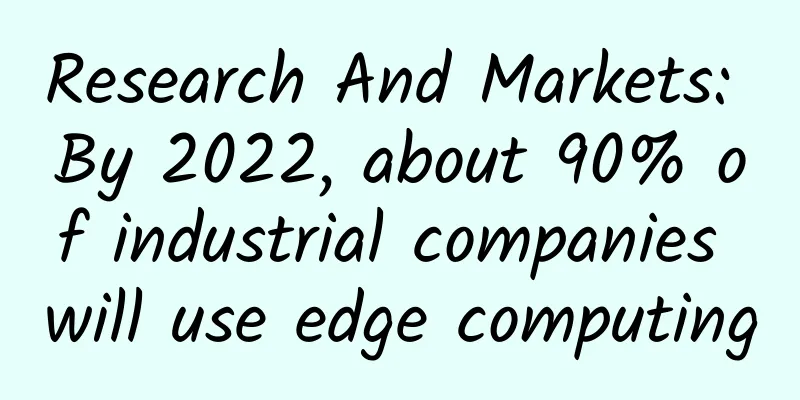Research And Markets: By 2022, about 90% of industrial companies will use edge computing

|
On February 6, a new report released by market research firm Research And Markets predicted that by 2022, about 90% of industrial enterprises will use edge computing, and even before 5G coverage reaches a higher level and use cases mature, most data will be processed at the edge. There have been three major computing revolutions in industrial applications, namely mainframe, client-server, and cloud computing. From the starting points of these paradigms, edge computing is becoming a foundational technology for industrial enterprises with its lower latency, robust security, responsive data collection, and lower costs. The report points out that the multi-access edge computing market is still in its infancy, with telecom operators and cloud service providers conducting trials. As a new generation of mobile communication technology, 5G has lower latency and higher capacity, coupled with edge computing, which brings computing power closer to customers and promotes new applications and experiences. Operators are now deploying smaller data centers at the edge of the network, closer to customers, to optimize application performance. However, telecom operators cannot implement and manage edge computing alone. They must build partnerships and application ecosystems to capture this growth opportunity. As a result, operators are working with cloud providers to improve the performance of existing mission-critical applications and support new applications over wireless networks. This market impacts growth opportunities in many areas for both consumer and enterprise use cases where low latency requirements for connectivity are critical for applications and user experience. For consumers, there are innovative applications such as 5G gaming and augmented reality, virtual reality and ultra-high definition streaming. For enterprises, telecom operators are deploying private wireless networks to enable Manufacturing 4.0, automated mining, precision agriculture, Industrial IoT, and other compelling use cases. Analysts expect that by 2022, about 90% of industrial companies will use edge computing, and even before 5G coverage reaches higher levels and use cases mature, most data will be processed at the edge. Edge computing refers to computing that pushes intelligence, data processing, analysis, and communication capabilities to the source of data, either at the network gateway or directly at the endpoint. The goal is to reduce latency, ensure efficient networking and operations, as well as service delivery and improved user experience. By extending computing closer to the data source, edge computing supports latency-sensitive computing, provides greater business agility through better control and faster insights, reduces operating costs, and is supported by more efficient network bandwidth. |
<<: 5G private network is a big watermelon (Part 3): Difficulty in synthesis
Recommend
80VPS: Hong Kong server monthly payment starts from 420 yuan, US CN2 monthly payment starts from 650 yuan, Hong Kong/US cluster server starts from 750 yuan
I have shared information about 80VPS many times ...
An overlooked "secret weapon" in the 5G era may break the market monopoly
Recently, the Ministry of Industry and Informatio...
LOCVPS new Japanese SoftBank line VPS, native IP, 20% discount promotion
After the Lunar New Year, LOCVPS launched a new V...
5G is not yet popular, 6G is on the way, and 7G will achieve space roaming
[[332143]] This article is reprinted from the WeC...
Hosteons launches IPv6 VPS starting at $6 per year, with data centers in Los Angeles/Salt Lake City/New York
Hosteons currently offers two VPS hosts that only...
The operating data of the three major operators in 2018, how did they perform this year?
2018 has passed. This year was a year of hard wor...
13 key technical differences between SD-WAN providers
Choosing the right software-defined WAN vendor ca...
Overcoming the Security Challenges of Software-Defined Networking
Today, more and more organizations are embracing ...
Want to be a data scientist? See if you have these 5 qualities
【51CTO.com Quick Translation】 Data science career...
IPv6+, a new starting point for the next generation Internet
As of July 2020, the number of users allocated IP...
In-depth analysis of the difficulties and challenges of 5G core network construction
At present, the core network is in a critical per...
Banwagong: Los Angeles CN2 annual payment starts from $46.5, 1-10Gbps US CN2 GIA/Hong Kong CN2 GIA/Japan CN2 GIA
Bandwagonhost VPS was founded in 2012 and is affi...
U.S. Department of Commerce: Will allow U.S. companies to work with Huawei to develop 5G network standards
[[330263]] In the early morning of June 16th, Bei...
The next generation of wireless standards: What's different about Wi-Fi 6
Wi-Fi 6 is the next generation wireless standard ...
What is DNS? Why are there only 13 DNS root servers? Is it really that difficult to give one to China?
The Domain Name System is one of the most importa...
![[Black Friday] Psychz Los Angeles server monthly payment starts at $15, E3 series monthly payment starts at $29](/upload/images/67cac47640d06.webp)








